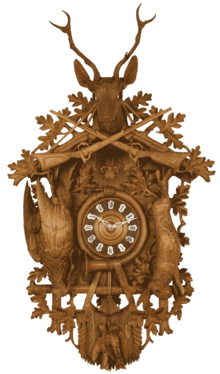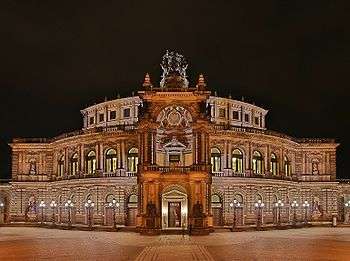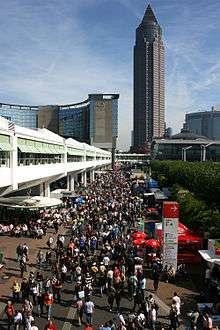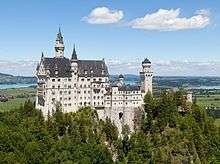Tourism in Germany
.jpg)

Germany is the seventh most visited country in the world,[1][2] with a total of 407.26 million overnights during 2012.[3] This number includes 68.83 million nights by foreign visitors, the majority of foreign tourists in 2009 coming from the Netherlands, the United States and Switzerland (see table). Additionally, more than 30% of Germans spend their holiday in their own country. According to Travel and Tourism Competitiveness Reports, Germany is rated as one of the safest travel destinations worldwide.
The official body for tourism in Germany is the German National Tourist Board (GNTB), represented worldwide by National Tourist Offices in 29 countries. Surveys by the GNTB include perceptions and reasons for holidaying in Germany, which are as follows: culture (75%), outdoors/countryside (59%), cities (59%), cleanliness (47%), security (41%), modernity (36%), good hotels (35%), good gastronomy/cuisine (34%), good accessibility (30%), cosmopolitanism/hospitality (27%), good shopping opportunities (21%), exciting nightlife (17%) and good price/performance ratio (10%) (multiple answers were possible).
In 2012, over 30.4 million international tourists arrived in Germany, bringing over US$38 billion in international tourism receipts to the country.[4] Domestic and international travel and tourism combined directly to contribute over EUR43.2 billion to the German GDP. Including indirect and induced impacts, the industry contributes 4.5% of German GDP and supports 2 million jobs (4.8% of total employment).[5] The ITB Berlin is the world's leading tourism trade fair.[6]
History
The history of tourism in Germany goes back to cities and landscapes being visited for education and recreation. From the late 18th century onwards, cities like Dresden, Munich, Weimar and Berlin were major stops on a European Grand tour.
Spas and Seaside resorts on the North and Baltic Sea (e.g. Rugia and Usedom islands, Heiligendamm, Norderney and Sylt islands) particularly developed during the 19th and early 20th century, when major train routes were built to connect the seaside spas to urban centers. An extense bathing and recreation industry materialized in Germany around 1900. At rivers and close to natural landscapes (along the Middle Rhine valley and in Saxon Switzerland for example) many health spas, hotels and recreational facilities were established since the 19th century.
Since the end of World War II tourism has expanded greatly, as many tourists visit Germany to experience a sense of European history and the diverse German landscape. The country features 14 national parks, including the Jasmund National Park, the Vorpommern Lagoon Area National Park, the Müritz National Park, the Wadden Sea National Parks, the Harz National Park, the Hainich National Park, the Saxon Switzerland National Park, the Bavarian Forest National Park and the Berchtesgaden National Park. In addition, there are 14 Biosphere Reserves, as well as 98 nature parks.
The countryside has a pastoral aura, while the bigger cities exhibit both a modern and classical feel. Small and medium-sized cities often preserved their historical appearance and have old towns with remarkable architectural heritage - these are called Altstadt in German.
Statistics

The table below shows the distribution of national and international visitor nights spent in each of the sixteen states of Germany in 2008. With 76.91 million nights spent in hotels, hostels or clinics, Bavaria has the most visitors. With 14.300 nights per 1,000 population, Mecklenburg-Vorpommern has the highest density of tourists.
|
Most visitors arriving to Germany on short term basis in 2014 were from the following countries of nationality:[7]
| Rank | Country | Number |
|---|---|---|
| 1 | 4,237,865 | |
| 2 | 2,778,455 | |
| 3 | 2,415,477 | |
| 4 | 2,371,086 | |
| 5 | 1,725,259 | |
| 6 | 1,642,443 | |
| 7 | 1,617,901 | |
| 8 | 1,466,561 | |
| 9 | 1,310,693 | |
| 10 | 1,033,470 | |
| Total international arrivals | 32,999,298 | |
Countryside
Health
About 242 million nights, or two-thirds of all nights spent in hotels in Germany, are spent in spa towns.[8] Germany is well known for health tourism, with many of the numerous spa towns having been established at a hot spring, offering convalescence (German: Kur) or preventive care by means of mineral water and/or other spa treatment. Spa towns and seaside resorts carry official designations such as Mineral and mud spas (Mineral- und Moorbäder), Healthy climate resorts (Heilklimatische Kurorte), Kneipp cure resorts (Kneippkurorte = water therapy resorts), Seaside resorts (Seebäder), Climatic resorts (Luftkurorte), and Recreation resorts (Erholungsorte). The largest and most well known resorts also have casinos, most notably at Bad Wiessee, Baden-Baden (Kurhaus), Wiesbaden (Kurhaus), Aachen, Travemünde and Westerland (Kurhaus).
Regions


The most visited tourist regions in Germany are the East Frisian and North Frisian Islands, the Baltic Sea coasts of Holstein, Mecklenburg and Vorpommern, the Rhine Valley, the Bavarian and Black Forest, and the Bavarian Alps.
The table below shows the five most visited rural districts in 2008:[9]
| rank | district | # of nights in 2008 |
|---|---|---|
| 1 | Nordfriesland | 6.96 million |
| 2 | Rügen | 5.57 million |
| 3 | Oberallgäu | 5.29 million |
| 4 | Ostholstein | 5.27 million |
| 5 | Breisgau-Hochschwarzwald | 4.41 million |
Other popular regions include
- in the North: Usedom, Holstein Switzerland, the Lüneburg Heath, Harz and Mecklenburg Lake District
- in the West: Teutoburg Forest, Sauerland, Eifel and the Moselle Valley
- in the East: Saxon Switzerland, Thüringer Wald, Erzgebirge and the Elbe Valley
- in the South: Taunus, Spessart, Rhön, Odenwald and Allgäu.
Theme routes

Since the 1930s, local and regional governments have set up various theme routes, to help visitors get to know a specific region and its cultural or scenic qualities. The table below shows some of the most prominent theme routes. Other popular German theme routes include parts of the European Route of Brick Gothic and European Route of Industrial Heritage, the Harz-Heide Road, Bertha Benz Memorial Route and Bergstrasse.
| Route | Established | Theme | Length |
|---|---|---|---|
| German Wine Road (Deutsche Weinstraße) | 1935 | Palatinate wine route | 85 km |
| German Avenue Road (Deutsche Alleenstraße) | 1993 | Tree-sided avenues and lush countrysides | 2900 km |
| Romantic Road (Romantische Straße) | 1950 | Romanticism | 366 km |
| Black Forest High Road (Schwarzwaldhochstraße) | 1952 | Black Forest | 60 km |
| Castle Road (Burgenstraße) | 1954 | Castles in Germany | 1,000 km |
| Road of Weser Renaissance (Straße der Weserrenaissance) | Weser Renaissance | 350 km | |
| Romanesque Road (Straße der Romanik) | 1993 | Romanesque architecture | 1,195 km |
| German Ferries Route | 2004 | Fords, ferries, bridges and tunnels | 250 km |
| German Timber-Frame Road | 1990 | Timber framing (Fachwerk) | 3,000 km |
| German Clock Road (Deutsche Uhrenstrasse) | Cuckoo clock Manufacturers, clock-face paintings workshops, museums, Black Forest and Baar villages, landscapes |
320 km | |
| Industrial Heritage Trail (Route der Industriekultur) | Industrial heritage of the Ruhr area | 400 km | |
| German Fairy Tale Route (Deutsche Märchenstraße) | Fairy tales and legends of the Brothers Grimm | 600 km |
Winter sport

The main winter sport regions in Germany are the Bavarian Alps and Northern Limestone Alps, as well as the Ore Mountains, Harz Mountains, Fichtel Mountains and Bavarian Forest within the Central Uplands. First class winter sport infrastructure is available for alpine skiing and snowboarding, bobsledding and cross-country skiing.
In most regions, winter sports are limited to the winter months November to February. During the Advent season, many German towns and cities host Christmas markets.
Cities
In terms of numbers of overnight stays, travel to the twelve largest cities in Germany more than doubled between 1995 and 2005, the largest increase of any travel destination.[10] This increase mainly arises from growth of cultural tourism, often in conjunction with educational or business travel. Consequently, the provision and supply of more and higher standards of cultural, entertainment, hospitality, gastronomic, and retail services also attract more international guests.
The table below shows the ten most visited cities in Germany in 2012. Other cities and towns with over 1 million nights per year are Rostock, Hannover, Bremen, Cuxhaven, Bonn, Freiburg, Münster, Lübeck, Wiesbaden, Essen and Regensburg.
Berlin
Berlin has a yearly total of about 135 million day visitors, which puts it in third place among the most-visited city destinations in the European Union. Berlin had 781 hotels with over 125,000 beds in June 2012.[11] The city recorded 20.8 million overnight hotel stays and 9.1 million hotel guests in 2010.[12] In the first half of 2012, there was an increase of over 10% compared to the same period the year before.[11]
Hamburg
In 2007, more than 3,985,105 visitors with 7,402,423 overnight stays visited the city.[13] The tourism sector employs more than 175,000 people full-time and brings in revenue of €9.3 billion, making the tourism industry a major economic force in the Hamburg Metropolitan Region. Hamburg has one of the fastest-growing tourism industries in Germany. From 2001 to 2007, the overnight stays in the city increased by 55.2% (Berlin +52.7%, Mecklenburg-Western Pomerania +33%).[14]
A typical Hamburg visit includes a tour of the city hall and the grand church St. Michaelis (called the Michel), and visiting the old warehouse district (Speicherstadt) and the harbour promenade (Landungsbrücken). Sightseeing buses connect these points of interest. As Hamburg is one of the world's largest harbours many visitors take one of the harbour and/or canal boat tours (Große Hafenrundfahrt, Fleetfahrt) which start from the Landungsbrücken. Major destinations also include museums.
The area of Reeperbahn in the quarter St. Pauli is Europe's largest red light district and home of strip clubs, brothels, bars and nightclubs. The Beatles had stints on the Reeperbahn early in their careers. Others prefer the laid-back neighbourhood Schanze with its street cafés, or a barbecue on one of the beaches along the river Elbe. Hamburg's famous zoo, the Tierpark Hagenbeck, was founded in 1907 by Carl Hagenbeck as the first zoo with moated, barless enclosures.[15]
 Berlin is Germany's largest and most visited city
Berlin is Germany's largest and most visited city The Brandenburg Gate at night
The Brandenburg Gate at night- The Oktoberfest in Munich is the world's largest fair
 Hamburg is the second largest city in Germany
Hamburg is the second largest city in Germany Frankfurt is the financial center of Germany and Continental Europe
Frankfurt is the financial center of Germany and Continental Europe- Heidelberg with its famous Castle ruins
.jpg)
 Düsseldorf with the Rheinturm
Düsseldorf with the Rheinturm The Semperoper in Dresden is the most famous opera house in Germany
The Semperoper in Dresden is the most famous opera house in Germany Dresden Frauenkirche at sunset
Dresden Frauenkirche at sunset
 View over Nuremberg Castle
View over Nuremberg Castle
 View over Leipzig
View over Leipzig Bremen in northern Germany
Bremen in northern Germany
 Cuxhaven at the North Sea coast
Cuxhaven at the North Sea coast- The small town of Rothenburg ob der Tauber is a destination for tourists from around the world
- Nördlingen is another small town popular with tourists
 Wittenberg was the home of Martin Luther and is now a UNESCO world heritage
Wittenberg was the home of Martin Luther and is now a UNESCO world heritage
 Freiburg im Breisgau in the Black Forest
Freiburg im Breisgau in the Black Forest Beach of Rostock (Warnemünde)
Beach of Rostock (Warnemünde)
Events
The table below shows some of the largest annually recurring events in Germany:
| type | event | location | season | # of visitors | notes | |
|---|---|---|---|---|---|---|
| Volksfest | Oktoberfest | Munich | September/October | 6.0 million | ||
| Volksfest | Cannstatter Volksfest | Stuttgart | September/October | 4.2 million | locally called "Cannstatter Wasen" | |
| Volksfest | Libori | Paderborn | End of July | 1.7 million | 9 days, one of the biggest and oldest central city events | |
| Fair | Largest Fair on the Rhine | Düsseldorf | July/August | 4.0 million | ||
| Sport event | Sailing regatta | Kiel Week | Kiel | July/August | 3.5 million | |
| Maritime festival | Hanse Sail | Rostock | 2nd weekend of August | 1.1 million | one of Europe's biggest events for sailors | |
| World Marathon Major | Berlin Marathon | Berlin | September | |||
| Carnival parade | Cologne Carnival | Cologne | February | 1.5 million | number of visitors for Rosenmontagszug | |
| Gay pride | Cologne Pride | Cologne | June/July | 1.2 million | ||
| contemporary art exhibition | Quadriennale Düsseldorf | Düsseldorf | September/January | only held every 4 years | ||
| documenta Kassel | Kassel | 0.9 million | only held every 5 years | |||
| Music festival | Techno music | Love Parade | varies | June/July | 1.6 million | * Further Events have been canceled following the Love Parade tragedy in 2010 |
| Rock music | Bochum Total | Bochum | June/July/August | 1.0 million | ||
| Rock music | Rock am Ring and Rock im Park | Nürburgring and Nuremberg | May/June | 0.8 million | ||
| Classical music | Schleswig-Holstein Musik Festival | throughout Schleswig-Holstein | July/August | 0.2 million | ||
| Anniversary | Port of Hamburg birthday | Hamburg | May 7 | 1.0 million | ||
| Fireworks show | Cologne Lights | Cologne | July | 1.0 million | ||
| Rhein in Flammen | Bonn | May | 0.5 million | |||
| Wine festival | Wurstmarkt | Bad Dürkheim | 2nd and 3rd Weekend in September | 0.6 million | ||
| Film festival | Berlinale (Berlin International Film Festival) | Berlin | February | 0.5 million | Film festival | |
Note: This list only includes the largest, annually recurring events in selected categories. This list may be incomplete.
Trade fairs


Germany is home to several of the world's largest trade fairgrounds, and many of the international exhibitions are considered trend-setters or industry leaders. Thousands of national and international trade fairs, conventions and congresses are held in Germany annually. In 2008, 10.3 million people visited the 150 largest trade fairs alone. More than half of these visitors come from abroad, more than one third from countries outside Europe. The table below shows some of the most visited trade fairs.
| trade fair ground | city | trade fair | industry | # of visitors[16][17] | notes |
|---|---|---|---|---|---|
| Messe Frankfurt | Frankfurt am Main | Internationale Automobilausstellung (IAA) | motor show | 850,000 in 2009 | held in Hanover every other year as a truck show |
| Frankfurt Book Fair | books | 300,000 in 2008 | |||
| ISH | heating, ventilation and air conditioning | 201,000 in 2009 | biennial | ||
| Messegelände | Hanover | CeBIT | computer expo | 334,000 | 87,000 foreign visitors |
| Hannover Messe | industrial technology | 250,000 in 2011 | world's biggest industrial fair | ||
| Messe München International | Munich | BAUMA | construction machinery | 530,000 in 2013 | triennial |
| BAU | architecture, materials, systems engineering | 212,000 in 2009 | biennial | ||
| Messe Berlin | Berlin | International Green Week (IGW) | sustainable agriculture | 425,000 | 9,000 foreign visitors |
| Internationale Funkausstellung (IFA) | consumer electronics | 240,000 in 2012 | |||
| Messe Düsseldorf | Düsseldorf | Drupa | print media | 390,000 | 230,000 foreign visitors, quadrennial |
| Boot Düsseldorf | boats | 267.000 | 43,000 foreign visitors | ||
| Kunststoffmesse (K) | plastics | 242,000 in 2007 | triennial | ||
| koelnmesse | Cologne | gamescom | video games | 345,000 in 2015 | organised by Leipzig Trade Fair until 2008 as Games Convention |
Note: This list only includes trade fairs with 250,000 visitors per year or more. This list may be incomplete.
Most visited...
Protected areas
The table below shows the most visited protected areas in Germany.
| rank | protected area | location | type | # of visitors in 2002[18] | # of visitors in 2008 |
|---|---|---|---|---|---|
| Western Pomerania Lagoon Area National Park | Mecklenburg-Vorpommern | National park | 2.50 million | 3.00 million[19] | |
| Saxon Switzerland National Park | Saxony | National park | 2.15 million | 2.90 million[20] | |
| Bavarian Forest National Park | Bavaria | National park | 2.00 million | ||
| Jasmund National Park | Mecklenburg-Vorpommern | National park | 2.00 million | ||
| Lower Saxony Wadden Sea National Park 1 | Lower Saxony | National park | 2.00 million | ||
| Berchtesgaden National Park | Bavaria | National park | 1.50 million | ||
| Harz National Park | Lower Saxony, Saxony-Anhalt | National park | 1.50 million | ||
| Schleswig-Holstein Wadden Sea National Park 1 | Schleswig-Holstein | National park | 1.50 million | ||
| Mainau Island | Baden-Württemberg | 1.30 million |
Note: This list only includes protected areas with 1 million or more visitors per year. This list may be incomplete.
Landmarks

The German Tourism Association (Deutscher Tourismusverband) irregularly publishes statistics on the most visited landmarks. With an average of over 6 million visitors entering Cologne Cathedral per year, the cathedral is Germany's most visited landmark. Second and third places go to the Reichstag building in Berlin and the Hofbräuhaus in Munich. Other much visited architectural landmarks include the Drosselgasse in Rüdesheim (3.0m), the medieval old towns of Rothenburg ob der Tauber (2.5m), Regensburg (2.0m), Frauenkirche in Dresden (2.5m), Bad Münstereifel (2m), the Brandenburg Gate in Berlin and the Holsten Gate in Lübeck 1.
| rank | landmark | location | subject | # of visitors in 2002[18] | # of visitors in 2007 |
|---|---|---|---|---|---|
| 1 | Cologne Cathedral 1 | Cologne | Gothic Cathedral | 6.0 million | 6.0 million[21] in 2004 |
| 2 | Reichstag building | Berlin | Bundestag | 2.70 million | 2.70 million[22] in 2006 |
| 3 | Hofbräuhaus | Munich | Brewery | 1.80 million[23] | |
| 4 | Heidelberg Castle | Heidelberg | Renaissance architecture | 1.30 million | |
| 5 | Neuschwanstein Castle | Schwangau | Castle of King Ludwig II of Bavaria | 1.25 million | 1.36 million[24] |
| 6 | Zwinger and Gemäldegalerie Alte Meister | Dresden | Staatliche Kunstsammlungen Dresden | 1.20 million | |
| 7 | Fernsehturm | Berlin | Television and observation tower | 1.10 million | |
| 8 | Aachen Cathedral 1 | Aachen | Imperial Cathedral | 1.0 million | 1.5 million[25] |
Note: This list only includes physical landmarks with 1.0 million visitors per year or more. This list may be incomplete.
Theme parks
The table below shows some of the most visited theme parks or related facilities in Germany.
.jpg)
| Name | Location | Type | No. of visitors in 2002[18] | Nr. of visitors in 2008 |
|---|---|---|---|---|
| Europa-Park | Rust | Amusement park | 3.5 million | 4.0 million[26] |
| VW Autostadt | Wolfsburg | Automobile park | 2.1 million | |
| Nürburgring | Nürburg | Formula One park | 2.0 million | |
| Therme Erding | Erding | Water park | 1.5 million | |
| Movie Park Germany | Bottrop | Amusement park | 1.3 million | |
| Legoland Deutschland | Günzburg | Miniature park | 1.3 million | |
| Berlin Zoological Garden | Berlin | Zoo | 3.0 million | |
| Leipzig Zoological Garden "Zoo of the future" | Leipzig | Zoo | 1.2 million | 2.1 million |
| Phantasialand | Brühl | Amusement park | 1.75 million | |
| Heide Park Resort | Soltau | Amusement park | 1.6 million | |
| Deutsches Museum | Munich | Museum | 1.4 million | |
| Hamburg Planetarium | Hamburg | Planetarium | 0.4 million |
Note: This list only includes the largest theme parks/facilities in selected categories. This list may be incomplete.
See also
- Transport in Germany
- Public holidays in Germany
- List of museums in Germany
- List of world's largest cuckoo clocks
- Economy of Germany
- Cuisine of Germany
- Tourism in East Germany
- German tourism industry
- List of World Heritage Sites in Germany
References
- ↑ "Interim Update" (PDF). UNWTO World Tourism Barometer. UNWTO. April 2011. Retrieved 26 June 2011.
- ↑ http://dtxtq4w60xqpw.cloudfront.net/sites/all/files/pdf/unwto_highlights13_en_hr_0.pdf
- 1 2 Zahlen Daten Fakten 2012 (in German), German National Tourist Board
- ↑ "Tourism Highlights 2013 edition" (PDF). UNWTO. Retrieved 2013-11-26.
- ↑ "2013 Travel & Tourism Economic Impact Report Germany" (PDF). WTTC. Archived from the original (PDF) on 2013-12-03. Retrieved 2013-11-26.
- ↑ "ITB Berlin: The World's Leading Travel Trade Show". http://www.expodatabase.com. M+A Expo Database. Retrieved 13 September 2016. External link in
|website=(help) - ↑ Tourismus in Zahlen 2014, Statistisches Bundesamt
- ↑ Overnight stays by groups of communities, Statistisches Bundesamt, Wiesbaden
- ↑ "Tourismus- und Hotelatlas 2009-2010" (PDF) (in German). Georg & Ottenströer. p. 8.
- ↑ Städte- und Kulturtourismus in Deutschland, German Tourism Association (DTV)
- 1 2 "Strong tourism and convention destination Berlin". visitBerlin. Retrieved 13 August 2012.
- ↑ "Berlin-Tourismus 2010 mit neuem Rekord" (PDF). Amt für Statistik (in German). Archived from the original (PDF) on 19 July 2011. Retrieved 19 February 2011.
- ↑ Staff (29 February 2008), Newsletter Nr. 18 (PDF), Hamburg Tourismus GmbH, retrieved 13 August 2008 External link in
|publisher=(help) (German) - ↑ Staff (11 July 2008), Umsatzbringer und Jobmotor Tourismus (in German), Behörde für Kultur, Sport und Medien, archived from the original on 9 August 2010, retrieved 13 August 2008
- ↑ Rene S. Ebersole (November 2001). "The New Zoo". Audubon Magazine. National Audubon Society. Retrieved 1 October 2008.
- ↑ Euro Fair Statistics 2008, Society for Voluntary Control of Fair and Exhibition Statistics (FKM)
- ↑ Audited Trade Fair and Exhibition Figures 2008, Society for Voluntary Control of Fair and Exhibition Statistics (FKM)
- 1 2 3 Deutscher Tourismusverband, German Tourism Association (DTV)
- ↑ Mehr als drei Millionen Besucher jährlich, Die Welt, 15 October 2008
- ↑ Immer mehr Besucher im Nationalpark, Mitteldeutscher Rundfunk, 12. March 2010
- ↑ Der Kölner Dom, Hessischer Rundfunk
- ↑ Das Parlament, February 2008
- ↑ Zapfhahn 2007, Hofbräuhaus, page 9
- ↑ epochtimes.de
- ↑ Tourismus-Barometer, Aachen district, 2008
- ↑ Europa-Park Facts, March 2010
- Statistisches Bundesamt Deutschland (Federal Statistical Office)
- DZT / World Travel Monitor
- World Tourism Organization
External links
| Wikivoyage has a travel guide for Germany. |
- Official Germany tourism website (German) (Arabic) (Czech) (Danish) (English) (Spanish) (Finnish) (French) (Hebrew) (Hungarian) (Italian) (Japanese) (Korean) (Dutch) (Norwegian) (Polish) (Portuguese) (Russian) (Slovene) (Swedish) (Chinese)
-
 Media related to Tourism in Germany at Wikimedia Commons
Media related to Tourism in Germany at Wikimedia Commons - Germany travel and tourism at DMOZ
